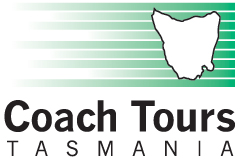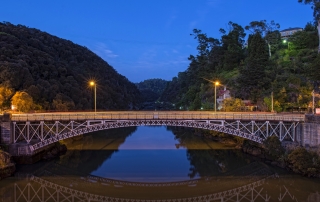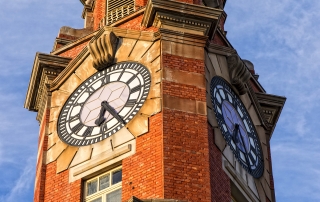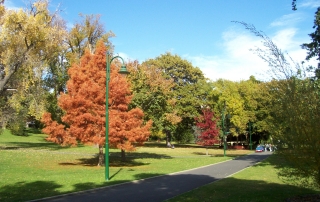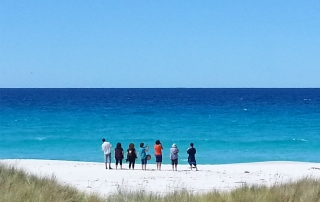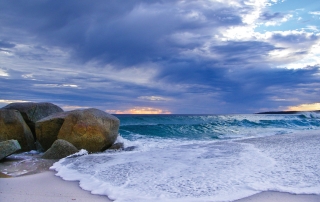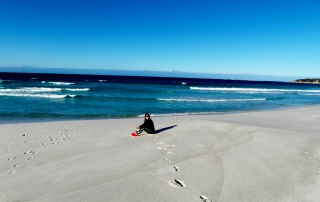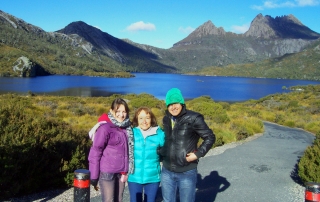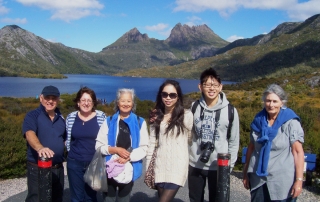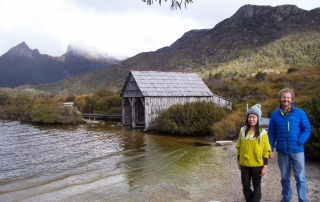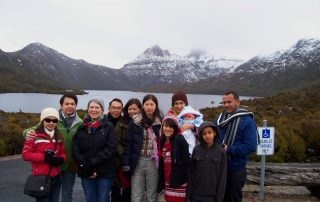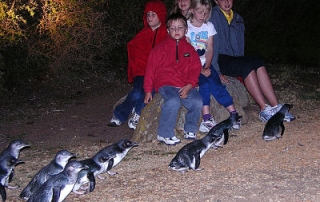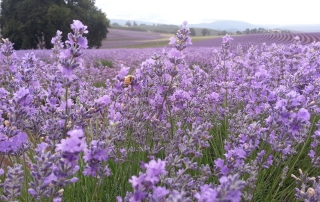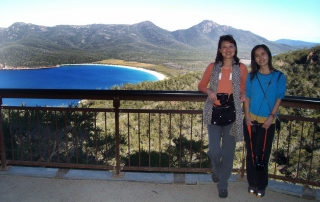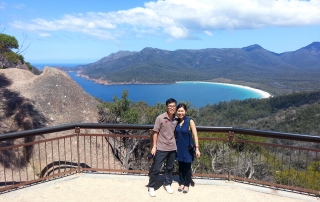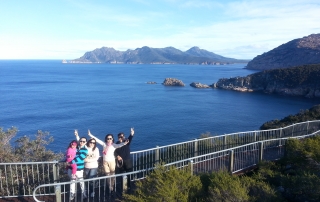Launceston
Tasmania’s “northern capital” of Launceston was established in 1806 by free settlers. It has fine Victorian buildings from the 1870s and 1880s and elegant contemporary architecture. The unique attraction of Cataract Gorge is a natural wonder only a 15-minute walk from the city centre, and not far from the J Boag and Son brewery. Cool climate wines and fine dining are the essence of the new Launceston experience and the city is a perfect base from which to explore the surrounding region. The tidal River Tamar flows north from Launceston to George Town and Bass Strait, past forested hills and pastures, lavender plantations, vineyards, strawberry farms and orchards. Excellent restaurants, superb boutique wineries and simple roadside stalls ensure every appetite is indulged and this idyllic setting will satisfy other interests too, from history enthusiasts to nature lovers. You can explore by road or cruise the long curve of the Tamar River. North east of Launceston is Scottsdale with its Forestry EcoCentre, en route to the popular port and seaside town of Bridport, famous for fishing; the purple haze of lavender fields at Nabowla; and the links golf course, Barnbougle Dunes. Beneath the Great Western Tiers, to Launceston’s west, is the pretty town of Deloraine, that every year hosts Australia’s biggest working craft fair, while to the south down the Midlands Highway, are authentic examples of Tasmania’s “living history”. In Evandale, Longford, Campbell Town and Ross, you will find 19th century grand country manors, workers’ cottages and peaceful town centres that are home to thriving country communities today.
Bay of Fires
The Bay of Fires has been luring holiday makers for decades. Named by ‘Lonely Planet’ in 2009 as the world’s hottest travel destination, the Bay of Fires has to be included on your Tasmanian holiday itinerary.
Spend peaceful hours snorkelling in the region’s crystal clear lagoons, inlets and bays. Place endless footprints along the endless stretches of perfectly white sand. A fascinating aquatic world can be discovered with local guided diving and snorkelling tours. View scenic reefs, spectacular sponges and corals, underwater caves, and abundant marine life including weedy sea dragons, boarfish, abalone and wandering rock lobsters in excellent year-round visibility of up to 20 metres.
Extending from Binalong Bay, 10 kilometres north of St Helens, in the south to Eddystone Point in the north, the Bay of Fires is a glorious combination of untouched wilderness and perfect strands of beaches.
Laid-back and relaxing, Binalong Bay is a charming village of holiday homes and campsites hidden among the acacia trees fringing the shores, and a great place to take time out swimming, boating, fishing, kayaking and walking.
Scenic lagoons border nearby Humbug Point Nature Recreation Area at secluded and lovely spots like Skeleton Bay, Grants Point and Elephant Head. Popular for bushwalking and bird-watching, the Humbug Point heathlands attract a rich array of birdlife including yellow-tailed black cockatoos, wattlebirds and honeyeaters, while seabirds seen in the area include magnificent white-breasted sea eagles, Pacific gulls, gannets, petrels and albatross.
In spring, the area is ablaze with wildflowers, including native orchids and the distinct yellow flowers of native Banksia.
Further north is Cosy Corner Beach, situated on the road to the delightful little holiday hamlet known as The Gardens, simply breathtaking.
Cradle Mountain
Cradle Mountain forms the northern end of the wild Cradle Mt – Lake St Clair National Park, itself a part of the Tasmanian Wilderness World Heritage Area. The jagged contours of Cradle Mountain epitomise the feel of a wild landscape, while ancient rainforest and alpine heathlands, buttongrass and stands of colourful deciduous beech provide a range of environments to explore. Icy streams cascading out of rugged mountains, stands of ancient pines mirrored in the still waters of glacial lakes and a wealth of wildlife ensure there is always something to captivate you. The area is one of the most popular natural areas in Tasmania. A visit will reveal why.
Cradle is the starting point for the world-famous Overland Track, a magnificent 6 day walk that will take you through the heart of some of the finest mountain terrain.
Tamar Valley
Launceston has recreated itself and now has some of Australia’s top restaurants and stylish places to stay. Walk, relax, visit the peacocks, or dine in wild and beautiful Cataract Gorge in the centre of town. The Tamar Valley has boutique cool climate wineries, and elegant vineyard restaurants where you can meet with the growers and the makers. Nearby historic towns such as Evandale and Longford preserve the architecture and community spirit of a 19th century village but are also very much of today. Tasmania’s “northern capital” of Launceston was established in 1806 by free settlers. It has fine Victorian buildings from the 1870s and 1880s and elegant contemporary architecture. The unique attraction of Cataract Gorge is a natural wonder only a 15-minute walk from the city centre, and not far from the J Boag and Son brewery. Cool climate wines and fine dining are the essence of the new Launceston experience and the city is a perfect base from which to explore the surrounding region. The tidal River Tamar flows north from Launceston to George Town and Bass Strait, past forested hills and pastures, lavender plantations, vineyards, strawberry farms and orchards. Excellent restaurants, superb boutique wineries and simple roadside stalls ensure every appetite is indulged and this idyllic setting will satisfy other interests too, from history enthusiasts to nature lovers. You can explore by road or cruise the long curve of the Tamar River. North east of Launceston is Scottsdale with its Forestry EcoCentre, en route to the popular port and seaside town of Bridport, famous for fishing; the purple haze of lavender fields at Nabowla; and the links golf course, Barnbougle Dunes. Beneath the Great Western Tiers, to Launceston’s west, is the pretty town of Deloraine, that every year hosts Australia’s biggest working craft fair, while to the south down the Midlands Highway, are authentic examples of Tasmania’s “living history”. In Evandale, Longford, Campbell Town and Ross, you will find 19th century grand country manors, workers’ cottages and peaceful town centres that are home to thriving country communities today.
Wineglass Bay
Freycinet National Park is a peninsula of pink granite mountains, pure white beaches, coastal dunes and dry eucalypt forests on the Island’s east coast. French explorer Nicolas Baudin named the land mass in 1802 after one of two Freycinet brothers, who were officers on his ship. The highest peak in the Hazard Range is Mt Freycinet at 620 metres (2,034 feet). US magazine Outside has named Wineglass Bay one of the top 10 beaches in the world. The park is famous for Wineglass Bay, just one of its white sandy beaches and the pure clear turquoise waters that are perfect for sea kayaking, swimming and scuba diving. The Hazard Range offers climbing, abseiling and mountain walking, and the coastal heathlands have wonderful day walks. Bird lovers may see a white-bellied sea eagle gliding overhead or large Australasian gannets diving for food. In the forested areas you will often see or hear small nectar-feeding birds such as eastern spinebills and yellow-throated or crescent honeyeaters and yellow-tailed black cockatoos, which often feed and fly in raucous groups. Moulting Lagoon Game Reserve, just outside the park on the Coles Bay road, is a wetland of international importance. Walks in the area include Cape Tourville (20 minutes), Wineglass Bay Lookout (1 – 1.5 hours), Wineglass Bay (2.5 hours), Hazards Beach (3.5 hours). There is also the Freycinet Circuit which is a 2 day trek.
